White–Juday warp-field interferometer
The White–Juday warp-field interferometer is an experiment designed to detect a microscopic instance of a warping of spacetime. If such a warp is detected, it is hoped that more research into creating an Alcubierre warp bubble will be inspired. A research team led by Harold "Sonny" White in collaboration with Dr. Richard Juday[1] at the NASA Johnson Space Center and Dakota State University are conducting experiments, but results so far have been inconclusive.
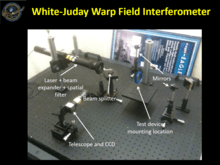
Motivation for the experiment
The NASA research team led by Harold White and their university partners currently aim to experimentally evaluate several concepts, especially a redesigned energy-density topology, as well as an implication of brane cosmology theory. If space actually were to be embedded in higher dimensions, the energy requirements could be decreased dramatically and a comparatively small energy density could already lead to a measurable (i.e. using an interferometer) curvature of spacetime.[2] The theoretical framework for the experiment dates back to work by Harold White from 2003, as well as work by White and Eric W. Davis from 2006 that was published in the AIP, where they also consider how baryonic matter could, at least mathematically, adopt characteristics of dark energy (see section below). In the process, they described how a toroidal positive energy density may result in a spherical negative-pressure region, possibly eliminating the need for actual exotic matter.[3]
Theoretical framework
The metric derived by Alcubierre was mathematically motivated by cosmological inflation.
Interferometer experiment
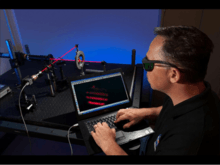
The original device proposed by White after finding the energy-decreasing possibilities (see theoretical framework) is a modified Michelson interferometer that uses a λ = 633 nm beam from a helium–neon laser. The beam is split into two paths, with the space-warping device placed in or near one beam path. The space warp would induce a relative phase shift between the split beams that should be detectable, provided that the magnitude of the phase shift created by the change in apparent path length is sufficient. By using 2D analytic signal processing, the magnitude and phase of the field can be extracted for study and comparison to theoretical models. The researchers first tried to see whether the space warping by the electric-field energy of a high-voltage (up to 20 kV) ring (0.5 cm radius) of high-κ barium titanate ceramic capacitors could be detected. After the first tests the experiment was moved to a seismically isolated lab due to very high interference caused by people walking outside the room. The goals circa 2013 were to increase sensitivity up to 1/100 of a wavelength and implement the oscillating field in order to get definite results.[3][4][5][6][7][8][9][10]
Results
White announced the first results of his interferometer experiment at a 2013 space conference. According to White, these results showed a vanishing but non-zero difference between charged and uncharged states after signal processing, but this difference remains inconclusive due to external interference and limits in the computational processing.[9][11] It is now clear that no exotic matter is involved in such an experiment, but some other concept is being used.[12][13]
Interferometer experiment with a resonant cavity
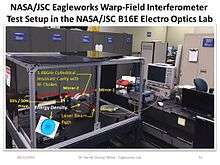
During the first two weeks of April 2015, scientists fired lasers through a microwave cavity and noticed highly significant variations in the path time. The readings indicated that some of the laser pulses traveled longer, possibly pointing to a slight warp bubble inside the resonance chamber of the device. However, a small rise in ambient air temperature inside the chamber was also recorded, which could possibly have caused the recorded fluctuation in speeds of the laser pulses. According to Paul March, a NASA JSC researcher, the experiment was to be verified inside a vacuum chamber to remove all interference of air. This was done at the end of April 2015.[14][15] White does not think, however, that the measured change in path length is due to transient air heating, because the visibility threshold is 40 times larger than the predicted effect from air.
The experiment used a short, cylindrical, aluminum resonant cavity (and not a tapered resonant cavity)[16] excited at a natural frequency of 1.48 GHz with an input power of 30 watts, over 27000 cycles of data (each 1.5 s cycle energizing the system for 0.75 s and de-energizing it for 0.75 s), which were averaged to obtain a power spectrum that revealed a signal frequency of 0.65 Hz with amplitude clearly above system noise. Four additional tests were successfully conducted that demonstrated repeatability.[17]
Warp-drive research and potential for interstellar propulsion
The NASA research team has postulated that their findings could reduce the energy requirements for a spaceship moving at ten times the speed of light ("warp 2") from the mass–energy equivalent of the planet Jupiter to that of the Voyager 1 spacecraft (c. 700 kg)[2] or less.[18]
By harnessing the physics of cosmic inflation, future spaceships crafted to satisfy the laws of these mathematical equations might actually be able to get somewhere unthinkably fast and without adverse effects.[19]
Physicist and EarthTech CEO Harold E. Puthoff has explained that, contrary to widespread belief, even the highly blue-shifted light seen on board such a spaceship would not fry its crew, being bathed in strong UV light and X-rays. It would, however, be dangerous to anyone seeing it fly by closely.[9]
Gallery
 White–Juday warp-field interferometer process description.
White–Juday warp-field interferometer process description.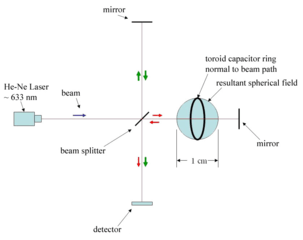
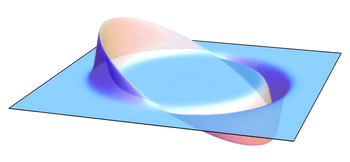 Visualisation of York time, a measurement of spacetime curvature. Positive height corresponds to spatial expansion, negative height to contraction. The central region corresponds to flat spacetime.
Visualisation of York time, a measurement of spacetime curvature. Positive height corresponds to spatial expansion, negative height to contraction. The central region corresponds to flat spacetime.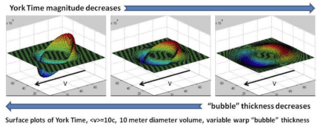 Surface plots of York time effects showing the expansion or contraction of space. This shows the relative change in energy density for several warp-bubble wall thicknesses.
Surface plots of York time effects showing the expansion or contraction of space. This shows the relative change in energy density for several warp-bubble wall thicknesses. Test results of the resonant cavity using the Eagleworks warp-field interferometer CCD camera (4 April 2015)
Test results of the resonant cavity using the Eagleworks warp-field interferometer CCD camera (4 April 2015) Warp-field path length changes due to air temperature
Warp-field path length changes due to air temperature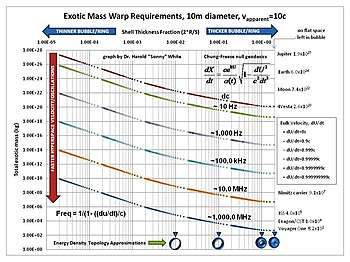 Warp requirements for 10 m OD sphere
Warp requirements for 10 m OD sphere
Media reaction
Research on this device and other proposed devices is notable as the original newsletter from the NASA center[19] and later presentations at a NASA conference[3] detailed NASA funding of research in advanced concepts[20][21][22] and in this particular case in the work proposed by Miguel Alcubierre, physical effects that have potential applications to space travel. In addition, these news releases included the researchers' enthusiastic descriptions of the potentials with statements such as: "... while this would be a very modest instantiation of the phenomenon, it would likely be a Chicago pile moment for this area of research..." Several space technology newsletters[23] and space society organizations have further publicized these claims.[18] Keith Cowing of the blog NASA Watch questions the oversight of this line of research by NASA[24] and requested an explanation.[25] Another journalist says that although a practical warp drive is a long way off, serious efforts to learn more about it are being undertaken now.[5] At the second 100 Year Starship Symposium, White told Space.com, "We're trying to see if we can generate a very tiny instance of this in a tabletop experiment", the project is a "humble experiment" but said it represents a promising first step: "The findings I presented today change it from impractical to plausible and worth further investigation."[23]
See also
- Spacecraft propulsion
- Faster-than-light
- Krasnikov tube
- Exact solutions in general relativity – for more on the Alcubierre spacetime solution
- Quantum vacuum plasma thruster – another proposed device from the same NASA laboratory
- IXS Enterprise
References
- "Warp Factor". Popular Science.
- White, Harold (January 2013). "Warp Field Mechanics 102: Energy Optimization". NASA Johnson Space Center. Retrieved 2013-07-29.
- White, H.; Davis, E. (2006). M. S. El-Genk (ed.). "The Alcubierre Warp Drive in Higher Dimensional Space-time" (PDF). Proceedings of Space Technology and Applications International Forum. American Institute of Physics. Retrieved 19 February 2013.
- Dr. Harold “Sonny” White (2011-09-30). "Warp Field Mechanics 101" (PDF). NASA Johnson Space Center. Retrieved 2013-01-28.
- Dodson, Brian (October 3, 2012). "Warp drive looks more promising than ever in recent NASA studies". Gizmag.
- Dr. Harold “Sonny” White; Paul March; Nehemiah Williams & William O’Neill (12 May 2011). "Eagleworks Laboratories: Advanced Propulsion Physics Research" (PDF). NASA Johnson Space Center. Retrieved 10 January 2013.
- Marc G. Millis; Eric W. Davis (2009). Frontiers of Propulsion Science. American Institute of Aeronautics and Astronautics. doi:10.2514/4.479953. ISBN 978-1-56347-995-3.
- White, Harold G. (2003). "A Discussion on space-time metric engineering". General Relativity and Gravitation. 35 (11): 2025–2033. Bibcode:2003GReGr..35.2025W. doi:10.1023/A:1026247026218.
- Dr. Harold “Sonny” White (2013-08-17). "2013 Starship Congress: Warp Field Physics, an Update". Icarus Interstellar. Retrieved 2013-08-17.
- White, H. (2013). Warp Field Mechanics 101. Journal of the British Interplanetary Society, vol. 66, pp. 242–247.
- White, Harold. "Warp Field Physics" (PDF).
- Harold White (2014). Dr. Harold "Sonny" White - Eagleworks Laboratories: Advanced Propulsion (Videotape). NASA Ames Research Center. Retrieved 6 March 2015.
- Harold White (2014). Warp drive and Harold White: A question with no answer (Videotape). Marco Frasca. Retrieved 6 March 2015.
- Re: EM Drive Developments - related to space flight applications - Thread 2 - msg1361931.
- Mack, Eric. "Is NASA one step closer to warp drive?". CNET.
- Re: EM Drive Developments - related to space flight applications - Thread 2 - msg1361845.
- Evaluating NASA’s Futuristic EM Drive.
- Dvorsky, George (November 26, 2012). "How NASA might build its very first warp drive". io9. Retrieved 10 January 2013.
- "Roundup" (PDF). Lyndon B. Johnson Space Center. July 2012. Retrieved 2013-10-01.
- Atkinson, Nancy (August 9, 2011). "NIAC is Back: NASA Funds 30 Innovative Ideas that Just Might Work". Universe Today.
- Hall, Loura (11 October 2016). "Center Innovation Fund". NASA.
- "Electric Propulsion Group at NASA JPL". sec353ext.jpl.nasa.gov.
- Moskowitz, Clara (September 17, 2012). "Warp Drive May Be More Feasible Than Thought, Scientists Say". Space.com. Retrieved 10 January 2013.
- Keith Cowing (September 18, 2012). "Warp Drive Research at NASA JSC". NASA Watch. Retrieved 2013-02-19.
- Keith Cowing (April 12, 2013). "Clarifying NASA's Warp Drive Program". NASA Watch. Retrieved 2013-04-24.
External links
- YouTube video of Harold White - Faster than Light: Warp Drive - SpaceVision 2013 Conference
- YouTube video of Harold White - Dr Harold White's Presentation at the 2013 Starship Congress
- Jesus Diaz (17 September 2012). "NASA Starts Work on Real Life Star Trek Warp Drive".
- Einstein-Maxwell equations for asymmetric resonant cavities